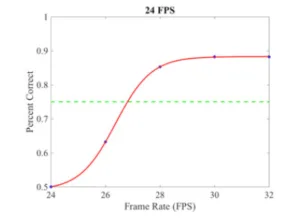Elizabeth DoVale and David Long from the Rochester Institute of Technology (RIT) started her presentation (which also won an award from SMPTE) by noting that as more films consider the possibility of shooting in HFR, the importance of conducting scientific study into human perception of motion quality becomes more crucial. What if humans perceive frame rate nonlinearly (similar to the function of perceived lightness versus luminance, CIE L*)? What if humans don’t perceive a change in frame rate above a certain point? Since the answers to these questions are unknown, RIT is doing some research in this area. One of their ideas is to try to develop the concept of a Just Noticeable Difference (JND) for frame rates.
They did experiments where participants were shown two different clips at different frame rates and were asked to describe the motion using words like smooth, fluid or sharp. The comparison stimuli for 24 FPS were 26FPS, 28 FPS, 30 FPS, 32 FPS and the stimuli for 48 FPS were 50 FPS, 52 FPS, 54 FPS, 56FPS, 58 FPS, 60 FPS, 62 FPS, 64 FPS, and 66 FPS. The comparison stimuli for 72 FPS were 80 FPS, 88 FPS, 96 FPS, 104 FPS, 112 FPS, and 120 FPS.
77 mostly college-age observers participated in the study. What they found was that the JND for 24 fps content is +2 to +4 fps for a 75% threshold level. This level means that 50% of the population can detect a difference in frame rates when 26 or 28 fps or higher when compared to the 24 fps reference.
At 48 fps, participants had a much harder time seeing differences which led to much “noisier” data and somewhat inconclusive results. Was the experiment too challenging or did participants “give up” and start guessing? If they lowered the JND threshold from 75% to 70% (meaning 40% of the population can see a difference), then a JND between 10 fps and 16 fps might be suggested by the data.
Applying this same lower threshold to the 72 fps data yields a JND of 24 to 36 fps. This data is so noisy that they think humans may not be able to adequately perceive a change in frame rate of 72 fps.
Some Questions
In comments following the presentations, questioners noted that brightness and field of view will also be key factors in the perception of motion. DoVale said they did maintain the viewing distance, so FOV fixed, but they only used one brightness level (she couldn’t remember at what luminance level, however).
Another questioner asked about the resolution of the display and said this may influence perception as well. DoVale agreed but she could not recall the resolution of their test display.
Sensitivity to flicker is also a factor in perception and decreases with age, so gathering more data with older viewers might be helpful.
DoVale liked all these comments and said she also wants to try using video content instead of the simple animated content of her test – and maybe make it into a game to keep the attention of the participants. DoVale has now graduated and taken a job at Dolby so who will continue this important research remains a bit unclear. – CC

